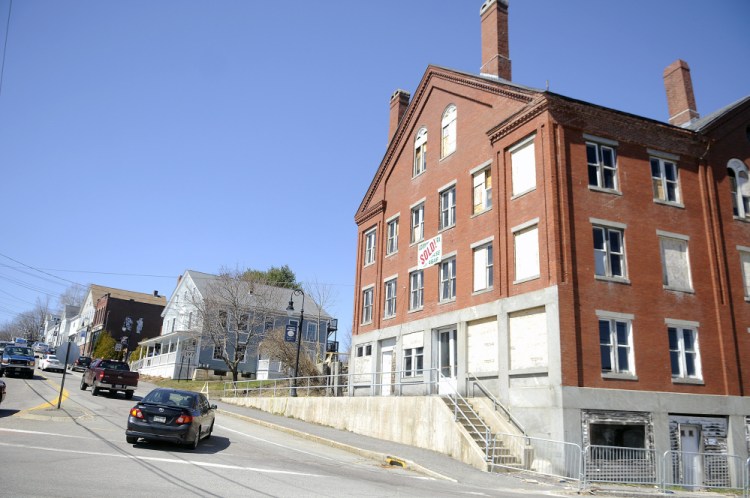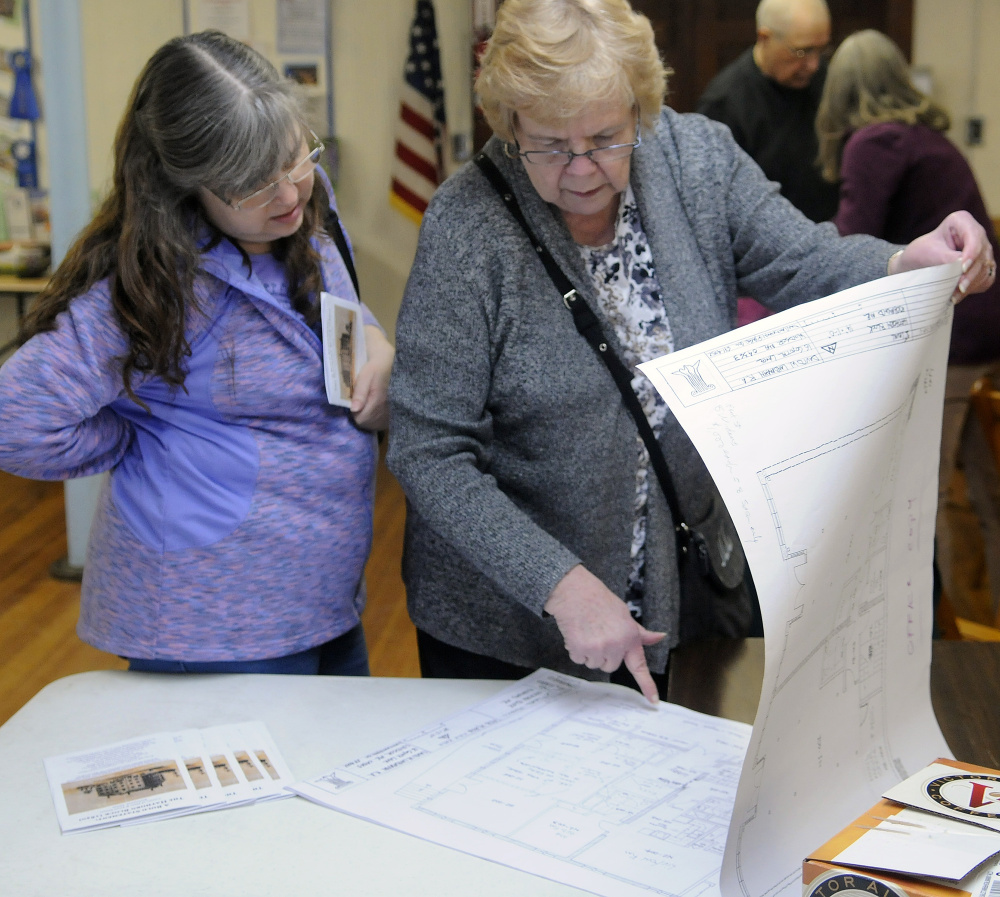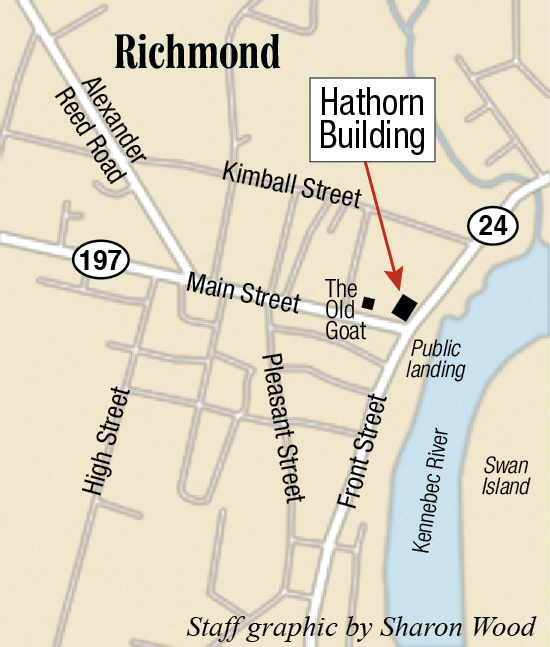RICHMOND — The future look of the large, red brick building at Main and Front streets known as the Hathorn Block or Klickstein Building was outlined Sunday afternoon by Les Fossel, the man directing its overhaul.
Fossel, of Fossel Preservation Partners LLC, described his plans for the 1850s, four-story-plus structure during a meeting hosted by Enterprise Grange, where more than 30 people — many familiar with the building — listened in rapt attention.
Fossel and partners purchased the 14,000-square-foot Hathorn Block last fall. They said at the time it would be rehabilitated as a mixed-use building — commercial on the ground floor, apartments on the upper floors. They paid $1 for it.
Rehabilitation of the building is seen as key to the character of the waterfront section of the town.
The building had been vacant for 18 years and was beginning to be viewed as a hazard because of deterioration. Water pouring in after the roof gave way rotted iron fasteners in the bricks, causing some walls to bow, and rusted holes through tin ceilings.
“Lots of pigeons lived in that building, and they’re gone,” Fossel said. “Don’t ask me how.” Selectmen had looked into having it torn down and learned it would cost about $140,000 to do so.
Jackie Lewis and her daughter Betsy Lewis-Bowie, who live on Front Street, said it’s wonderful to see working being done on the building.
“Everybody’s vying for those apartments that overlook the river,” Lewis said, after paging through the plans that Fossel brought to the presentation.
“It’ll certainly help Main Street,” Lewis-Bowie said.
Tom Nugent, too, is a Front Street neighbor of the building. “I’m very interested in seeing this building get refurbished,” Nugent said.
The Hathorn building was begun in late 1849 by brothers Jefferson and Jackson Hathorn, who aimed to have it be the largest structure in the town and near the Hathorn Wharf. It overlooks the landing for the ferry to nearby Swan Island, a wooded state wildlife management area.
In fact, every apartment in the building will have view of the Kennebec River, Fossel assured them as he offered a slideshow of the exterior and the rough interior.
“Right now we’re in Phase 1, a whole lot of cleanup,” Fossel said, describing large holes in the floor and the lack of usable staircases.
About a dozen people raised their hands when Fossel asked if any of them had been inside the building before.
“There are people in this room that know more about this building than I do,” he said.
“This is an absolutely spectacular building,” he said, shortly before noting that only one corner of the structure is square, hallways walls tend to tunnel inward, and charred beams and laths show that it had suffered four fires — including one that burned the roof off in the early 1900s.
“One of the things that saved the building long before we were here is that people built for the long run,” Fossel said. “Now it’s our turn to build for the long run.”
He told them he hopes to have the building ready for occupancy less than a year from now.
He estimated the two-bedroom apartments would be rented for around $1,300 a month. Some one-bedroom units will be offered as well.
Celeste “C.J.” Roy asked Fossel for a tour.
He said he might take one or two people through, but it’s too much a construction site for more than that. However, he added that he’s hoping to show the building to the public as part of the Richmond Days festivities, which occur annually in late July. He also wants to host a Business After Hours gathering of the Wiscasset Chamber of Commerce, where he served on the board, to show off Richmond’s prowess in economic development.
The Hathorn Block property size is tight at 0.6 acres, and because of changes in elevation, it has essentially three ground floors.
“You’ve got more building than you have land,” Fossel said. An easement over adjacent property will allow a driveway for residents to park indoors and outside. He said regulations require the building to have 22 parking spaces.
Slides of the interior showed new wood framing for the interior stairs and the location of an elevator.
It also showed curved stairways inside a number of the future apartments.
“The stairs are really good to look at and really dangerous to walk on,” Fossel said, adding that they will remain as aesthetic features only.
One attendee questioned an unusual placement of interior walls.
“We’re trying to respect existing window placement and as many of the original (wooden and brick) walls as possible,” Fossel said.
He said there has been good news for the rehabilitation as well. The old, soft brick holds a lot more air and adds to the insulation value; and some of the original arched windows and others can be reused, possibly with exterior storm windows to match.
Flat dormer windows will allow sunlight to flood into upstairs bedrooms in the penthouse apartments.
According to a building history prepared by Jay Robbins, the bricks used probably came from the Hathorns’ own brickyard, and the building was used both for commercial purposes and as a home for some of the Hathorn family members.
Over time, the Hathorn building housed the town’s post office, a bank, law offices, a grocery store and a hotel. Robbins’ history says that in 1892, “you could board by the day or the week at a cost of $2 per day.” At times, the building was sectioned off and portions were sold or leased.
An 1886 photo shows columns holding up a porch that spans one side of the building. Fossel said he wants to replace that porch.
Fossel, a former state legislator from Alna, has a lengthy history with the building. He was on the Maine Preservation board in 1997 when the Hathorn Block was put on that organization’s list of most endangered historical resources.
Fossel Preservation Partners includes architect David Landmann, John Hochstein and project manager Fred Gumkowski.
Fossel secured $100,000 loans from the town of Richmond’s revolving loan program and from Coastal Enterprises Inc., a nonprofit lender that specializes in rural business development, to help stabilize the building.
Part of that work included removing plywood that had boarded up many of the windows.
The rehabilitation is expected to cost some $2 million, to be funded by federal and state historic tax credits and loans.
Betty Adams — 621-5631
Twitter: @betadams
Send questions/comments to the editors.







Success. Please wait for the page to reload. If the page does not reload within 5 seconds, please refresh the page.
Enter your email and password to access comments.
Hi, to comment on stories you must . This profile is in addition to your subscription and website login.
Already have a commenting profile? .
Invalid username/password.
Please check your email to confirm and complete your registration.
Only subscribers are eligible to post comments. Please subscribe or login first for digital access. Here’s why.
Use the form below to reset your password. When you've submitted your account email, we will send an email with a reset code.